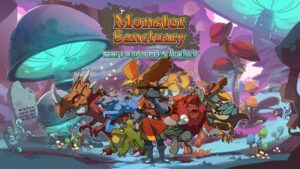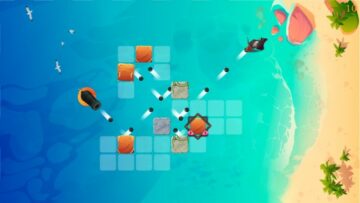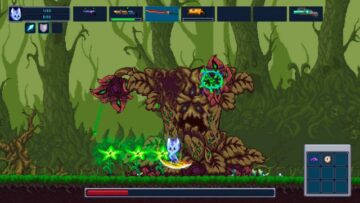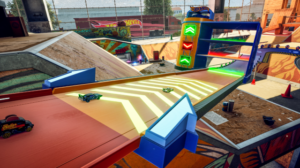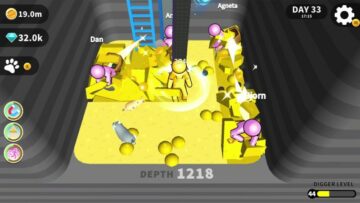MathLand made me show my age, as I reminisced about old educational games that combined gaming with maths, english, science and more. I’m going back to Granny’s Garden on the BBC Micro here, as well as things like Smile and Mario Teaches Typing. Since time immemorial, people have been trying to make learning fun.
MathLand has a plan for that. It plans to make mathematics something that pre-teens might actually want to do. It’s got exploration, cannonball-dodging, island-hopping and galleon piloting – all of the fun of the pirate fair – and then it brings in the sums. Addition, subtraction, multiplication, division and greater-than-or-less-than (comparisons) all jump aboard and start ransacking the place.
It’s quite hard to visualise, isn’t it? Can you just chuck mathematical equations into a game of Sid Meier’s Pirates and emerge with a working, engaging game? Well, you will be pleased to know that the answer is mostly yes, with an undertow of ‘but it doesn’t mix perfectly’.
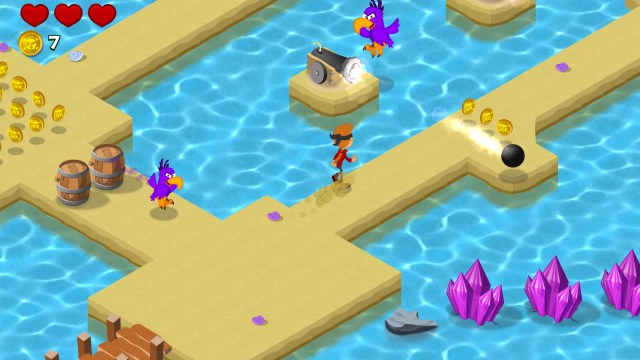

Let’s tackle the ‘entertainment’ part of this edutainment game first. Your mission is to collect all of the gems that have been scattered about the world. There’s a gem on every island of MathLand, and it’s helpfully in a chest at the end of that island. To get there, you travel on foot or aboard ship.
The on-foot bits are dead-simple. You explore a 3D-ish map, collecting coins on the way, avoiding the odd obstacle. There are piranha-plant-like creatures who will nibble a heart off your health, and cannons fire volleys of cannonballs at you. Later on, there are disappearing platforms and hidden holes. Most of the time, you’re just moving out of reach of issues. On occasion, your jump will be called into action, and you can heave-ho onto islands or up platforms. On other occasions, you will use your sword, which can’t be used to kill enemies, but it can be used to destroy barrels and crates.
In another game, we’d moan royally about the controls. The jump in particular is creakier than a captain’s cabin door, as it takes about a week to actually happen and, when it does, it’s inaccurate and offers no aftertouch to let you correct the direction. You’ll be flying into the water like a lemming on plenty of occasions. The sword attack, too, is ropey, as MathLand only lets you use it when you’re next to something that would smash. So, you’re often dancing around barrels, hoping the swipe will trigger. Get hit, and you will also lose multiple hearts, as there are no invincibility frames after an attack.
Control-wise, it can be a bit rubbish, but MathLand has some Get Out of Jail Free cards in the form of a general lack of challenge (MathLand has plenty of checkpoints and the jumps are never particularly difficult), and the fact it’s an educational game. We simply didn’t expect it to play like Hades.
Our little pirate would come across a jetty, and that means it’s pirate ship time. These are fun little sections where you can explore from island to island on a boat like an extremely stripped-back Wind Waker. On these islands, there might be valves that open up gates to explore further, or keys for doors. Even better, there are islands with collectible coins on, and these can be read, to find out more about legendary pirates of the past. You don’t only get to learn about maths in MathLand – your pirate knowledge will get a spritz too.
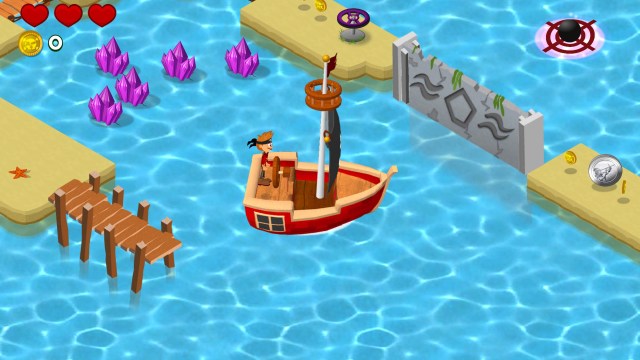
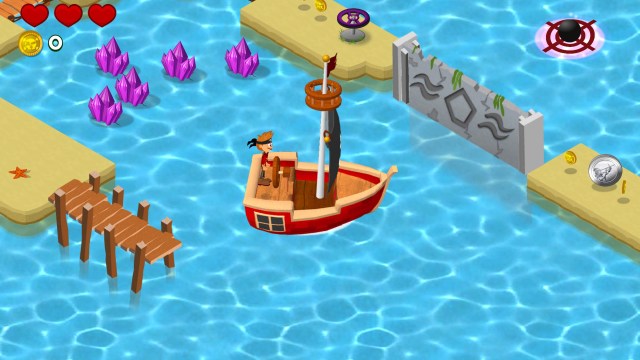
We’d have taken an entire game with these pirate ship sections, as we liked them a fathom-or-two more than the on-foot bits. They are a little more claustrophobic in size than we would have liked, but our kids loved them, hoovering up the green coins that are tucked in the corners of the map.
Overall, the ‘entertainment’ stuff is on the wooden side, not quite good enough to be a successful game on its own. But as a partner for the maths, it’s far better than we expected. It’s a more-than-adequate pay-off for the educational hard work.
The educational stuff crops up in two places. The first is as a kind of ‘unlock’ feature for the islands themselves. To visit an island, you need a number of spyglasses. These spyglasses are earned by completing your choice of sums. The categories are addition, subtraction, multiplication, division and ‘comparisons’, and choosing the category will set you up with a series of sums to complete and a time limit. Get enough of the sums right, and you will generate spyglasses that unlock the islands.
You can set the age-range for the sums, so there’s help on hand if you feel that your little player is too young for certain categories. Our eight-year old found the time limit to be panicking and unsettling, which was a shame – and not something you can turn off, either – but the sums were simple to understand and clear. There are gaps in the sum, and you have to fill those gaps with cards that are placed at the bottom of the screen. What’s 12 – 8? Grab the 4 card. When our eight-year old was confident, she could rattle through these quite easily.
We’re not syllabus setters or teachers, but we weren’t totally convinced by the structure of these sums on occasion. The ‘comparisons’ questions are just odd: you have to pick numbers that are bigger than other numbers (“which number is bigger than 1?”), and our child found it to be challenge-less. On the other end of the difficulty scale, you can choose categories where you construct sums yourself. Our child found it impossible to look at a Countdown-like selection of numbers and come up with the sums herself. The mathematics paralysis was real.
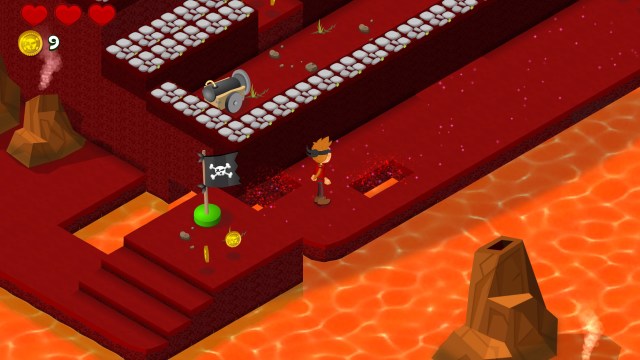
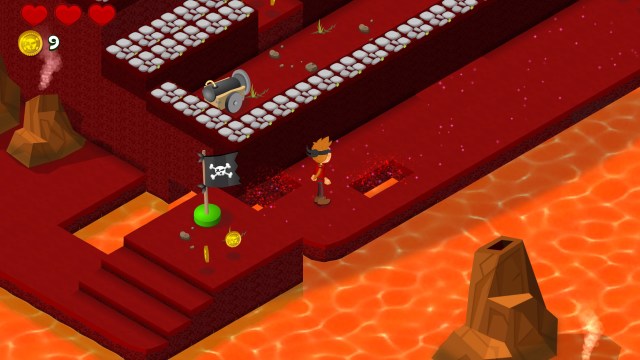
The other place where these sums turn up is within the levels themselves. An old man offers a key in exchange for correct answers, and they’re much the same as the ones you’ve played before, just restricted to the theme of the level. If you’re playing Addition Island, you will be getting addition questions.
Our biggest gripe is that the educational side of MathLand is not well integrated. Any game could ask the player to jump through equation hoops before playing (we’re waiting for Call of Duty to introduce some long-division before teens can play), so the blend of mathematics and buccaneering isn’t perfect. Mostly, you’re switching from maths brain to adventuring brain, rather than activating both at once. But it didn’t have to be that way: it’s not hard to imagine a version of MathLand where the addition or subtraction is within the gameplay. Choosing which enemies to attack, with one group being larger than the other, for example, seems a better approach to ‘greater than’ and ‘less than’.
Still, if you have a pre-teen player who loves gaming but struggles to knuckle down on their maths homework, then MathLand adds up nicely. It’s an entertaining game first, and a maths tutor second, and that makes it more palatable than tablet-based games like Times Table Rockstars.
Sure, the gameplay is on the ropey side, but MathLand sets its sights on making maths fun, and it scores a direct hit on that target.
- SEO Powered Content & PR Distribution. Get Amplified Today.
- PlatoAiStream. Web3 Data Intelligence. Knowledge Amplified. Access Here.
- Minting the Future w Adryenn Ashley. Access Here.
- Buy and Sell Shares in PRE-IPO Companies with PREIPO®. Access Here.
- Source: https://www.thexboxhub.com/mathland-review/
- 1
- 12
- 8
- a
- About
- across
- Action
- actually
- ADDITION
- adds
- after
- age
- AI
- All
- also
- an
- and
- Another
- answer
- any
- approach
- ARE
- around
- as
- At
- back
- bbc
- BE
- been
- before
- being
- Better
- bigger
- Biggest
- Bit
- boat
- both
- bottom
- brings
- but
- by
- called
- CAN
- card
- Cards
- categories
- certain
- challenge
- child
- choice
- choose
- Choosing
- clear
- Coins
- collect
- Collectible
- Collecting
- combined
- come
- complete
- confident
- Construct
- content
- controls
- corners
- correct
- could
- crops
- dancing
- data
- depths
- destroy
- difficult
- difficulty
- direct
- direction
- Division
- do
- does
- door
- doors
- down
- earned
- easily
- educational
- either
- emerge
- end
- engaging
- English
- enough
- entertaining
- entire
- even
- Every
- Example
- exchange
- expect
- expected
- exploration
- explore
- extremely
- fact
- fair
- far
- Feature
- feel
- find
- Fire
- First
- flying
- For
- form
- Free
- from
- fun
- further
- game
- gameplay
- Games
- Games Like
- Gaming
- gaps
- Garden
- Gates
- gem
- General
- generate
- Get
- getting
- going
- good
- grab
- Green
- Group
- hand
- Hard
- hard work
- has
- Have
- Health
- heart
- Hearts
- help
- here
- hidden
- HIT
- homework
- hoops
- hoping
- HTTPS
- i
- if
- imagine
- impossible
- in
- integrated
- into
- introduce
- Is
- Island
- issues
- IT
- ITS
- jail
- jpg
- jump
- just
- Key
- keys
- kids
- kind
- know
- knowledge
- lack
- larger
- later
- LEARN
- learning
- Legendary
- Level
- levels
- like
- LIMIT
- Little
- Look
- lose
- loved
- loves
- made
- make
- MAKES
- Making
- man
- map
- Mario
- mathematical
- mathematics
- means
- might
- Mission
- more
- most
- mostly
- moving
- much
- multiple
- my
- need
- never
- Next
- no
- not
- number
- numbers
- obstacle
- occasions
- Odd
- of
- off
- Offers
- often
- Old
- on
- once
- One
- ones
- only
- open
- or
- Other
- our
- out
- own
- palatable
- part
- particular
- particularly
- partner
- Past
- People
- perfect
- pick
- Pirates
- place
- places
- plan
- plans
- Platforms
- plato
- plato data intelligence
- platodata
- platogaming
- play
- played
- player
- Playing
- pleased
- Plenty
- questions
- quite
- rather
- reach
- read
- Real
- restricted
- review
- right
- same
- Scale
- Science
- Screen
- second
- seems
- selection
- Series
- set
- sets
- she
- show
- side
- Simple
- Simply
- since
- Size
- Smash
- So
- some
- something
- start
- structure
- successful
- sword
- table
- tackle
- taken
- takes
- Target
- teachers
- Teens
- than
- that
- The
- the world
- their
- Them
- theme
- themselves
- then
- there
- These
- they
- things
- this
- those
- Through
- time
- times
- to
- too
- totally
- travel
- trigger
- turn
- two
- Understand
- unlock
- up
- use
- used
- valves
- version
- Visit
- waiting
- want
- was
- Water
- way
- we
- week
- well
- were
- when
- where
- WHO
- will
- wind
- with
- within
- Work
- working
- world
- would
- yes
- you
- young
- your
- yourself
- zephyrnet


